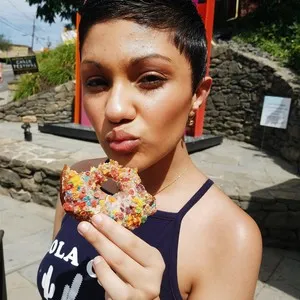We eat with our eyes. More than half the value we place on food comes from how it looks. We’re naturally attracted to vibrant colors, aesthetically-pleasing-yet-approachable spreads and visible textures. That’s why it’s incredibly important as food writers and photographers to showcase our meals’ good sides — the parts that make it visually delicious, like the vibrancy of a fruity sorbet or the texture of a gooey mac n’cheese.
Good foodstagrams will generate more than just traffic to your Spoon chapters. They will generate an interest in the restaurants you dine at and love, which is an added bonus, as well as rally your community.
As the Social Media Director of Spoon High School, foodie behind up-and-coming Instagram @honeybrunches, and cellphone photography-obsessed teenager, I think I know a thing or two about how to take the most drool-worthy foodstagram.
1. Stick With a Theme

We all have that one friend who spends a little too much time editing her photos before posting to Instagram for fear of her feed looking “messy.” While a tad too extreme, your friend does have a point.
People are attracted to cohesion. People like routine—so much so that it extends to social media. They like it when social media pages post similar content or have a similar aesthetic. Due to this, I prefer to use a unifying theme or aesthetic throughout my page.
The featured photo is a screenshot of my foodstagram, @honeybrunches. You’ll notice I love bright colors, so each of my posts has a decent dose of saturation. Other great unifiers include overhead shots or putting a small child in every single photo.
2. Post Regularly

Ideally, you want your posts to end up on people’s feeds at the same time each day with little deviation. Think of Instagram as a washing machine’s spin cycle. This creates brand loyalty. You want to sneak your way into your audience’s’ daily routine, becoming so regular that they can’t fathom not checking your feed. In order to create a fanbase so active they can rival Beliebers, post during “popular” times.
“Popular times” may differ depending on who your audience is. For the most part, you want to post during the time you usually check your phone. For example, I typically post for @spoonhighschool between 2:00-4:00 PM, or the hours when high schools typically let out, since high schoolers make up the majority of my audience.
3. It’s All About the Angles

We all know about angles, and no, I’m not talking about trigonometry. I’m talking about the angles you spend hours practicing in the mirror when you first learned how to take a selfie. Those same angles apply to food.
Each genre of food has different rule of thumb. Anything in a bowl, be it soup or salad, typically looks best in an overhead shot. As for sandwiches? Slice that baby open and pose it head on for a cross-section. The bottom line? Don’t be afraid to pose and play with your food.
4. Edit Your Photos

The entire point of Instagram (besides instant gratification ) is to paint a picture — a portrait of a life filled with perfectly golden stacks of pancakes, musical festivals, and inspirational street art. Social media is practically the only place where you can make others feel absolutely envious of every facet of your life, especially when it comes to food.
As foodstagrammers, we must enhance, not change, our meals. In other words, turn up the saturation, contrast, and exposure as you see fit. But don’t over-edit. Natural is key, after all.
5. Use All the Tags

Social media allows you to widen your chapter’s audience past the gates of your college campus to prospective students, locals, or just regular old foodies. However, these people aren’t looking for you. You need to look for them. The easiest way to do this is through utilizing all the tagging features on Instagram.
Geotags allow you to post directly to a restaurant’s location page, which is great for drawing in locals who are looking for something new.
Directly tagging a page not only draws their specific attention to your photo, it also heightens your chances of being reposted.
Good tags include the restaurant themselves, other local Spoon chapters, and Instagrams that, say, only post about ice cream.
Finally, hashtags also heighten your chances of being reposted and elevate your chapter to a national audience. I recommend hashtagging foodstagrams with major traction, like @infatuation, @zagat, and @nycdining. Once you find a set of hashtags that works for you, save them in a note so you can just copy and paste.
That’s it, ladies and ‘gents. Ultimately, the key to running a good foodstagram is to know your audience. Pay attention to the comments you receive and the number of likes you get. As with writing, interest drives content. As long as you keep one ear toward the people and your camera lens toward some food porn, you’re bound to see results.


